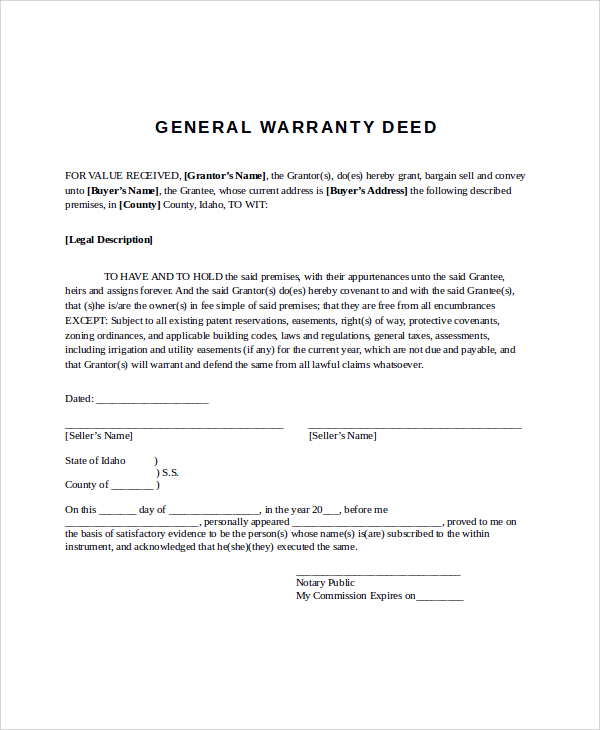If you must break the law, do it to seize power: in all other cases observe it.
Julius Caesar
Transfer of Real Property
by
Charles Lamson
A sale constitutes the most common reason for transferring title to real estate. In the ordinary case, the parties sign a contract of sale, but the title is not transferred until the seller delivers a deed to the buyer. A deed is a writing, signed by the owner, conveying title to real property. One may, by means of a lease, transfer a leasehold title giving the rights to the use and possession of land for a limited period. The provisions of the deed or the lease determine the extent of the interest transferred.
 |
Even when the owner makes a gift of real property, the transfer must be evidenced by a deed. As soon as the owner executes and delivers a deed, title vests fully in the donee. Acceptance by the donee is presumed.
Deeds
The law sets forth the form that the deed must have, and this form must be observed. The parties to the deed include the grantor, or original owner, and the grantee, or recipient. The two principal types of deeds are:
Quitclaim Deeds
A quitclaim deed is just what the name implies. The grantor gives up whatever interest he or she may have in the real property. However, the grantor makes no warranty that he or she has any claim to the property.
In the absence of a statute or an agreement between the parties requiring a warranty deed, a quitclaim deed may be used in making all conveyances of real property. A quitclaim deed transfers the grantor's full and complete interest as effectively as a warranty deed. When buying real property, however, one does not always want to buy merely the interest that the grantor has. A buyer wants to buy a perfect and complete interest so that the title cannot be questioned by anyone. A quitclaim deed conveys only the interest of the grantor and no more. It contains no warranties that the grantor has good title. In most real estate transactions, therefore, a quitclaim deed cannot be used because the contract will specify that a warranty deed must be delivered.
Warranty Deed
A warranty deed that not only conveys the grantor's interest in the real property but, in addition, makes certain warranties or guarantees. The exact nature of warranty or guarantee depends upon whether the deed is a general warranty or a special warranty deed. A general warranty deed (see Illustration 1) not only warrants that the grantor has good title to the real property but further warrants that the grantee "shall have quiet and peaceable possession, free from all encumbrances, and that the grantor will defend the grantee against all claims and demands from whomsoever made." This warranty, then, warrants that all prior grantors had good title and that no defects exist in any prior grantor's title. The grantee does not have to assume any risks as the new owner of the property.
ILLUSTRATION 1 General Warranty Deed  
A special warranty deed warrants that the grantor has the right to sell the real property. The grantor makes no warranties of the genuineness of any prior grantor's title. Trustees and sheriffs who sell land at a foreclosure sale use this type of deed. Executives and administrators also use such a deed. These officials should not warrant anything other than that they have the legal right to sell whatever interest the owner has.
When a builder sells the new house, most courts now impose an implied warranty of fitness not found in the deed. The warranty amounts to a promise that the builder designed and constructed the house in a workmanlike manner, suitable for habitation by the buyer.
Provisions in a Deed
Unless statutes provide otherwise, a deed usually has the following provisions:
Parties
The grantor and the grantee must be identified, usually by name, in the deed and the grantee must be a living or legal person. If the grantor is married, the grantor's name and that of a spouse should be written in the deed. If the grantor is unmarried, the word single or the phrase "a single person" should be used to indicate that status.
Consideration
The amount paid to the grantor for the property is the consideration. The payment may be in money or in money's worth. A deed usually includes a statement of the consideration, although the amount specified does not need to be the actual price paid. Some localities have a practice of indicating normal amount, such as $1, although a much larger sum was actually paid. The parties state a nominal amount as the consideration to keep the sale price from being a matter of public record.
Covenants
A covenant is a promise contained in a deed. There may be as many covenants as the grantor and the grantee wish to include. Affirmative covenants obligate the grantee to do something, such as agreeing to maintain a driveway used in common with adjoining property. In negative covenants the grantee agrees to refrain from doing something. Such covenants frequently appear in deeds for urban residential developments. The more common ones prohibit the grantee from using the property for business purposes and set forth the types of homes that can or cannot be built on the property. Most covenants run with the land, which means they bind all future owners.
Description
The property to be conveyed must be correctly described. Unless the law provides otherwise, any description that will clearly identify the property suffices. Ordinarily, however, the description used in the deed by which the present owner acquired the title should be used if correct. The description May be by lots and blocks if the property is in a city or it may be by metes and bounds or section, range, and township if the property is in a rural area. If the description is indefinite, the grantor retains title.
Signature
The grantor should sign the deed in the place provided for the signature. A married grantor must have the spouse also sign for the purpose of giving up a statutory right of the spouse. In some states a witness or witnesses must attest the signatures. If the grantor cannot sign the deed, an agent, the grantor with assistance, or the grantor making a mark, may execute it as:
 Acknowledgement
The statutes normally require that the deed be formally acknowledged before a notary republic or other officer authorized to take acknowledgements. The acknowledgment allows the deed to be recorded. After a deed has been recorded, it may be used as evidence in a court without further proof of its authenticity. Recording does not make a deed valid, but it helps give security of the title to the grantee.
The acknowledgement is a declaration made by the properly authorized officer, in the form provided for that purpose, that the grantor has acknowledged signing the instrument as a free act and deed. In some states the grantor must also understand the nature and effect of the deed or be personally known to the acknowledging officer. The officer attests to these facts and affixes an official seal. The certificate provides evidence of these actions.
Delivery
A deed has no effect on the transfer of an interest in real property until it has been delivered. Delivery consists of the grantor intending to give up title, possession, and control over the property. So long as the grantor maintains control over the deed and reserves the right to demand its return before delivery of the deed to the grantee, there has been no legal delivery. If the grantor executes a deed and leaves it with an attorney to deliver the grantee, there has been no delivery until the attorney delivers the deed the to the grantee. Since the attorney is the agent of the grantor, the grantor has the right to demand that the agent return the deed. Is The grantor, however, delivers the deed to the grantee's attorney or agent, then there has been effective delivery because releasing control constitutes evidence of intent that title passed. Once the grantor makes delivery, title passes.
Recording
Statutes in every state require grantees to file their deeds with a public official in the country in which the land lies. Any other instrument affecting title to real property in the country can also be filed. These public records of land transactions give notice of title transfers to all, particularly potential subsequent purchasers.

A deed need not be recorded in order to complete one's title. Title passes upon delivery of the deed. Recording the deed protects the grantee against a second sale by the grantor and against any liens that may attach to the property while still recorded in the grantor's name. Recording also raises the presumption of delivery of the deed.
When the recording official receives a deed for recording, the law ordinarily requires that the deed be stamped with the exact date and time the grantee leaves the deed for recording.
Abstract of Title
Before one buys real estate, an abstract of title may be prepared. An abstract company normally does this, but an attorney may also do it. The abstract of title gives a complete history of the real estate. It also shows whether or not there are any unpaid taxes and assessments, outstanding mortgages, unpaid judgments, or other unsatisfied liens of any type against the property. Once an abstracting company makes the abstract, an attorney normally examines the abstract to see if it reveals any flaws in the title.
Title Insurance
Some defects in the title to real estate cannot be detected by an abstract. Some of the most common of these defects are forgery of signatures in prior conveyances; claims by adverse possession; incompetency to contract by any prior party; fraud; duress; undue influence; defective wills; loss of real property by accretion; and errors by title examiners, tax officials, surveyors, and many other public officials. Title insurance policy can be obtained that will cover these defects. The policy may expressly exclude any possible defects that the insurance company does not wish to be covered by the policy. The insured pays one premium for coverage as long as the property is owned. The policy does not benefit a subsequent purchaser or a mortgagee.
*SOURCE: LAW FOR BUSINESS, 15TH ED., 2005, JANET E. ASHCROFT, J.D., PGS. 507-513*
end
|











